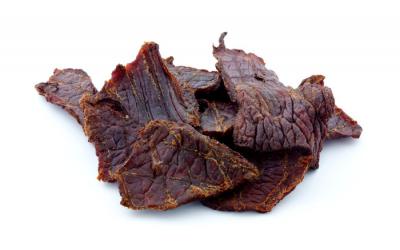Seasons by the Sea: Jerky, the Savage Treat

Cavemen invented it. Attila the Hun enjoyed the horse-meat variety. Pioneers and cowboys survived on it. We’re not talking about your 7-11 sodium nitrate–filled teriyaki version of it, we’re talking about real jerky, homemade jerky.
Jerking and smoking meats and fish can bring you back to a primal era, and this is the perfect time of year for it, with venison and game birds aplenty and post-holiday time on our hands. One advantage of meat from wild animals is the lower fat content, which is key for successful jerky. You can certainly use cheap, lean cuts of beef, such as round, flank, and sirloin tip. Turkey breast is also good.
Jerky is distantly related to pemmican, the pulverized dried meat mixture with berries and fat eaten by Native Americans. In China it’s called pork chip. In Italy there is coppiette — made in ancient times from the sinewy hind limbs of horses and donkeys — seasoned with red pepper and fennel seeds. Ethiopians make a dried beef called qwant’a with salt, pepper, and berbere, and in South Africa it’s called biltong. Jerky can be made with just about any edible animal, fish, bird . . . or snail.
The cavemen may have discovered the smoking method by accident. It’s easy to imagine them hanging strips of meat to dry with a fire burning nearby to keep away predators and insects. Lo and behold, the smoke sped up the process and added flavor.
There are two basic methods to making homemade jerky: in a dehydrator or in your oven at a low temperature. These homemade versions retain some moisture and therefore are perishable, so they need to be kept in airtight containers and refrigerated.
Salting meat helps dry it out and inhibits harmful microbes, and cooking with low heat then removes more moisture and weight, creating a highly concentrated protein-packed chewy treat.
Most of the recipes I have seen are similar and fairly straightforward. When making jerky with beef, you want to use any of the aforementioned cheap, lean cuts. Freezing the meat for one to four hours enables you to slice it very thinly. You should slice it along the grain, not against it. Next you marinate the slices in whatever flavors appeal to you. Liquid smoke, soy sauce, Worcestershire sauce, Tabasco, and brown sugar is one way to go. India pale ale with honey, soy, mustard seeds, garlic, and lime juice also works nicely. From here you can add hot peppers or pineapple juice, go Asian style with ginger, or improvise. (I think the addition of smoked paprika or chipotle would be good, as would maple syrup for a hint of sweetness.) Marinate for about eight hours, then drain. You can add a dry rub after marinating if you wish. Depending on your method and the thickness of your meat, the dehydrating/smoking process can take anywhere from 30 minutes to several hours. You may like it brittle, or perhaps a bit chewy.
If you are making jerky in your oven, set it to 165 degrees. Place meat on a wire rack sprayed with PAM over a baking sheet and cook for approximately one to three hours. Check the meat after one hour, turning it occasionally, then check again every 30 minutes. Some people leave their oven open just a crack to release more moisture.
If you knew what goes into most commercial jerky products you probably wouldn’t eat them. Okay, I’ll tell you. Those ubiquitous tubes and slices by the cash register are made with ground meat, gristle, tendons, cartilage, and connective tissue, all smashed together, then re-formed to resemble actual strips of lean meat. Throw in some sodium nitrates as preservatives, and you’ve got a pretty gross product.
If you own a smoker, you can get even more creative, spraying such delicacies as Dr. Pepper on the meat as it cooks. You wouldn’t want to mess up your oven with this.
We all have friends out here who hunt, so if you can, get one of them to give you some venison or duck to experiment with jerky. Otherwise, a nice turkey breast or piece of sirloin tip roast from the grocery store will get you started.
Click for recipes
